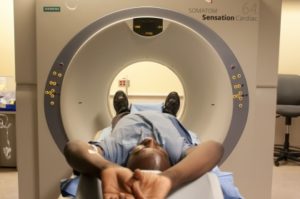
A veteran undergoes lung cancer screening at the Carl T. Hayden Veterans Affairs Medical Center in Phoenix, AZ. A new study found that veterans are more likely to receive a range of testing for cancer. VA photo.
TULSA, OK — While some cancer diagnoses are disproportionately high among VA patients, the cause does not appear to be inadequate screening, according to a new study.
While about 3% of invasive U.S. cancer diagnoses are made at the VA each year, the veteran patients only make up about 1.9% of the U.S. population, according to researchers from the Oklahoma State University Center for Health Sciences and colleagues, who add, “Although some research has shown that veterans have higher incidence rates of cancer compared to civilians, evidence is sparse regarding possible disparities in rates of cancer screening between these populations. Thus, the purpose of this study is to compare differences in rates of screening for colorectal, lung, breast, and cervical cancers between current and former U.S. military servicemembers and civilians.”
The study, published in Military Medicine, used data extracted from the Behavioral Risk Factor Surveillance System to assess cancer screening rates among current and former U.S. military servicemembers compared to civilians. To do that, the study team collected information from self-reported surveys of when colorectal or lung cancer screening had occurred among all participants and breast and cervical cancer for women participants. Those included in the cervical cancer screening were 25 or older, colon cancer screening were 50 or older, and for the breast cancer screening were 40 or older, the last of which was based on recommendations from the American Cancer Society.1
Results indicate that current and former U.S. military servicemembers were 2.6% of recipients of cervical cancer screening analysis, 2.2% for the breast cancer screening analyses, nearly 10% of the lung cancer screening and 15% of the colorectal cancer (CRC) screening analyses.
“Prevalence of screening was higher for current and former U.S. military servicemembers among lung cancer and CRC,” the authors wrote. “When controlling for age, race, education, and health care coverage, current and former U.S. military servicemembers were statistically more likely to be screened for CRC (ARR: 1.05; 95% confidence interval: 1.04-1.07) and lung cancer (ARR: 1.32; 95% confidence interval: 1.15-1.52). The odds of having completed a cervical or breast cancer screening were not significantly different between groups.”
Researchers point out that the study was one of the few to have directly compared cancer screening usage among civilians and current and former military servicemembers.
Veterans and servicemembers were found to be more likely to receive several cancer screenings, according to the authors, who advise that “improvements can still be made to remove barriers and increase screening usage due to the disproportionate rates of cancer mortality in this population. These solutions should be comprehensive—addressing personal, organizational, and societal barriers-to improve prognosis and survival rates among current and former U.S. military servicemembers.”
VA recommends routine screenings for four cancers: lung, colon and rectal (colorectal), breast and cervical. Age and certain risk factors, such as a past or current history of smoking and family history, all determine when a veterans qualifies for a cancer screening.
Cancer screening has lagged public health goals for years in community care. The 2015 National Health Interview Survey findings, the most recent published, showed that use of cancer screening tests for cervical, breast, and colorectal cancer remained below Healthy People 2020 targets.
National Centers for Disease Control and Prevention researchers reported that significant variation in test use by sociodemographic characteristics and access to care factors remained after adjustment. “For all tests studied, the lowest screening rates were generally associated with having no usual source of care, no insurance, not having seen a physician in the past 12 months, and identifying as non-Hispanic Asian,” they wrote. “Younger age, lower income, and fewer years of education were also consistently associated with lower prevalence of screening for both men and women. Examination of trends adjusted for these factors showed a persistent screening disparity over time for those uninsured or with no usual source of care.”2
- Weygandt J, Robling K, Whitaker LA, McPherson K, Hartwell M, Greiner B. Cancer Screening Among Current and Former U.S. Military Personnel Compared to Civilians: A Cross-Sectional Analysis of the Behavioral Risk Factor Surveillance System. Mil Med. 2021 Dec 4:usab439. doi: 10.1093/milmed/usab439. Epub ahead of print. PMID: 34865108.
- Hall IJ, Tangka FKL, Sabatino SA, Thompson TD, Graubard BI, Breen N. Patterns and Trends in Cancer Screening in the United States. Prev Chronic Dis. 2018 Jul 26;15:E97. doi: 10.5888/pcd15.170465. PMID: 30048233; PMCID: PMC6093265.

